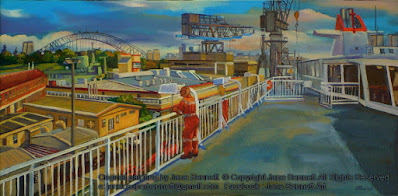
GI 5 'Spirit of Tasmania 1 in Captain Cook drydock'
2013 oil on canvas 45 x 92cm
It was an amazing experience to watch the whole operation of drydocking and I was so lucky to be able to paint it from the floor of the drydock, with the immense bulk of the ship looming up above me.
On this occasion the Spirit of Tasmania 1 was in drydock for about 3 weeks between July and August 2013.
Every sea-going vessel has to undergo this maintenance process twice within a period of 5 years.

GI 5 'Spirit of Tasmania 1 in Captain Cook drydock'
2013 oil on canvas 45 x 92cm
When the ship arrives at the dock, it has to be positioned accurately so that when the water is pumped out it will rest exactly on the blocks at the bottom of the dock.
Once the ship is in position, the entrance to the dock is closed using a
watertight gate, known as a caisson, sealing the ship off from the rest of the
harbour.
The time from when the stern of the ship first touches the blocks, to when the full weight of the ship is bourne by the blocks is the most crucial and potentially dangerous period in the entire operation.
The ship must rest on an even keel and not be lopsided or tilting down at one end.
Even 1 metre off the sender line could result in the ship toppling over.
Care also must be taken that the ship doesn't refloat after it is resting on the blocks.
When the ship is finally resting on the blocks it is called "Taking the blocks" and after all the water has been pumped out of the dock, then the inspection, cleaning and repairs can be carried out.
GI 11 'Captain Cook drydock Garden Island'
2013 oil on canvas 25 x 51cm
An
awe-inspiring 280 million litres of water had to be pumped out of the
Captain Cook graving dock before work on the ship can begin.
It is a hypnotic sight to watch the water slowly drain over a period of several hours.
This
is a painting of the southern end of the dock, and inside the walls you
can see the black depth indicators pointing like giant rulers into the
bottom of the dock. |
| Plein air oil painting of Spirit of Tasmania 1 in Garden Island Drydock |
Dry dock walls are built on a heroic scale. They need to resist the enormous hydrostatic forces unleashed when the dock is being dewatered.
They reminded me of the monumental architecture of lost ancient civilizations such as the Egyptian, Mesopotamian or Aztec.
The first major job was to wash the slime off the outer shell plating with high pressure waterjets. Although this certainly does make the ship look much prettier, the real reason is that it helps reduce fuel consumption and emissions.
Then the outer shell plating is coated with anti- corrosive paint, as seawater takes an enormous toll on any surface exposed to it. Any parts of the ship that will be submerged are then painted with a coat of anti-fouling paint.
Propellor
blades, rudders, underwater valves, cathodic protection systems,
anchors and cables must be inspected for corrosion and cracks.
There was also extensive work on the interior and the stern doors.
 |
| GI 7 'Andre on bridge of Spirit of Tasmania 1 in Captain Cook drydock' 2013 oil on canvas 25 x 51cm |
I included many of the contracters in my series of paintings. This, painted from the bridge of the ship also shows the soon to be demolished Hammerhead Crane set against the scenic backdrop of the Sydney Harbour Bridge.
Related Posts
Artist in Residence on the James Craig Part 1







